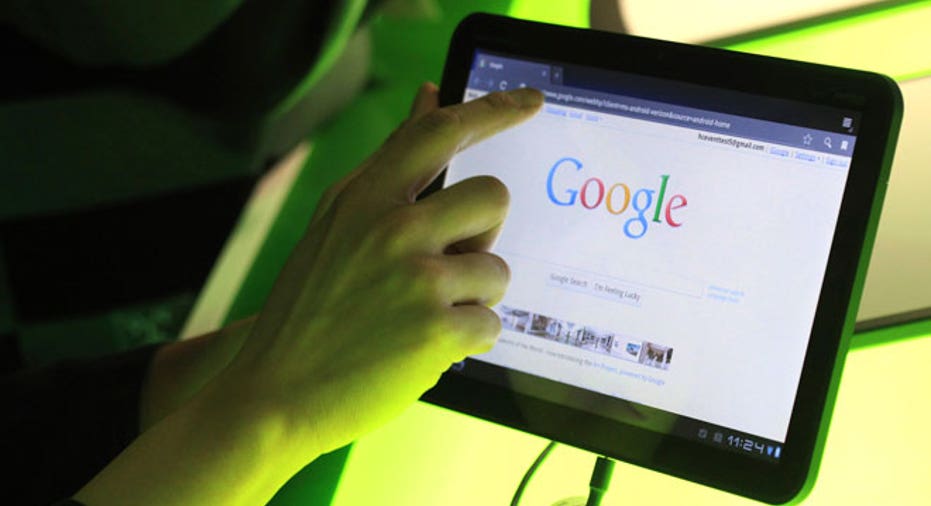Apps Begin to Give Blind Access to Touch Screens

While America's love affair with touch-screen payment devices continues to leave the blind and visually impaired in the dark, prospects for a hassle-free checkout in the near future are finally looking up.
Four years ago, CreditCards.com explored the obstacles to the blind posed by touch-screen devices. A sudden proliferation of the devices at point-of-sale services didn't bode well for America's 3.3 million blind people.
Without an audio interface or tactile buttons, what seem like technological advancements to the sighted leave the blind with no secure way to enter their debit card PIN or verify the payment total without help. Back then, their options were limited: Trust a stranger to enter (and not abscond with) your PIN, pay by credit or shell out cash and hope you paid the right amount and received the correct change.
The good news: The same technological innovation that caused this traffic backup in the first place has set about solving it, with an unlikely leader at the forefront: Apple.
The technology brand famous for its proprietary philosophy was the first to integrate accessibility into its entire product line, including the iPhone, iPad and iPod Touch. It's still not a payment solution, but it's a giant step toward one.
"Four years ago, most blind people would have said there was no real way to make a touch-screen device accessible, and Apple clearly did that," says Chris Danielsen, the spokesman for the National Federation of the Blind. "As a result, the iPhone, contrary to everyone's expectations, has become extremely popular among blind people."
By making the touch screen accessible via screen-access voice-over and magnification, Apple enabled the blind and visually impaired to surf the Web in ways they'd never imagined. As a result, the thousands of app developers looking to tap into Apple land tend to make their electronic tools accessible as well.
Oh, the places the blind can now go, thanks to iPhone apps! Here's a sampling:
- LookTel Money Reader instantly verbalizes each denomination of U.S. currency placed in front of the iPhone camera, no picture-taking required. (Did we mention that the United States stands alone among 180 currency-issuing jurisdictions as the only country that prints all denominations of all its bills the same size and color?)
- SayText scans and reads any text put before the iPhone camera, a godsend for things such as medical forms, restaurant menus and, in a pinch, a touch-screen display.
- Digit-Eyes not only audibly reads the product information (name, ingredients, even recipes) on 27 million grocery store items by scanning their bar codes, it also enables the blind to print their own QR labels at home so they can identify items in their pantry with their iPhone.
- LookTel Breadcrumbs GPS enables the blind to navigate via iPhone by dropping digital orientation tags, or "breadcrumbs," along their routes.
"It's been revolutionary," says Jonathan Simeone, a blind Oregon disabilities lawyer whose work with the advocacy group It's Our Money, Too helped the American Council for the Blind win a currency accessibility showdown with the U.S. Treasury. "I think Apple has actually done more for blind people than the blindness advocacy organizations."
Unfortunately, Apple remains one of the few beacons in a unenlightened manufacturing landscape that still leaves blind people lost in the supermarket. Unless a touch-screen ATM or POS talks or has tactile buttons, the blind are going to need help.
Near-field communications, or NFC, "contactless" payment terminals might be an option, but there are scant few of those around. Banks and merchants seem equally nonplussed by non-numeric identifiers such as fingerprint scans.
Tactile options
"What would be great would the equivalent of what we do now visually on touch screens in a more tactile way, for instance, by having the 'pay now' button pop up out of the screen," says Alison Roberts, a blind Boston member of It's Our Money, Too. "Machines that have buttons aren't millions of dollars more expensive."
A handful of recent designs attempt to bridge the vision gap from the other end by integrating pop-up Braille displays into a credit card and even a cellphone. While our panel of advocates appreciates the gesture and values Braille as the only real tool for blind literacy, they've grown weary of such workarounds when the technology now exists to make universal design a reality.
"If an app developer can sell you an app for less than $20 that will tell you the price, description, ingredients and cooking instructions of any item in your supermarket, how can that same supermarket tell you they can't come up with something that would tell you how much you're being charged for it at checkout?" asks Simeone. "The ATM in your store talks; why can't your point-of sale-device talk? If sighted people had no idea what they were being charged when they checked out, there would be outrage."
Still, Chris Danielsen says things are looking up. Taxicabs in Boston and New York City now boast fully accessible touch-screen payment devices. Some airlines will now scan a bar code on your smartphone to generate your boarding pass, allowing the blind to bypass the awkwardness of touch-screen kiosks. And a few brave merchants now offer an app that generates a one-time QR code on the iPhone to enable secure card payment without a separate PIN, although ironically it is not yet accessible to the blind.
"The trend is always toward more access," Danielsen says. "We're at this curious inflection point where the technology is definitely there, and if we could ever reach a tipping point where it is universally implemented, there wouldn't be any more problems. But we haven't reached that tipping point yet, and it's very hard to do in the current climate."



















